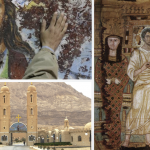By Raymond Ibrahim – Special for Coptic Solidarity –
Yet another Coptic Christian church has been consumed by flames. On Mar. 29, 2023, a massive fire broke out in the Church of the Virgin, Archangel Michael, Abu Sefein and Saint Anba Karas in Assyut, Egypt. Sections of it were reportedly “ancient.”
According to a statement from the diocese of Dairut:
The fire occurred around 4 a.m. and completely consumed the church and its appurtenances, as it was built of wood, as well as the ancient church, which consists of walls and a wooden ceiling.
Fortunately, no lives were lost in the conflagration.
According to the diocese’s statement—which was issued immediately after the catastrophe, that is, without waiting for professional investigations or forensics—the fire was due to a “leaky gas bottle.” This may well be true, but considering that some one thousand Coptic churches have been intentionally set aflame and/or bombed in Muslim Egypt since the 1970s, it is, of course, difficult to completely ignore arson as a possible culprit.
That said, whereas open arson attacks on Coptic churches have dwindled of late, “accidental” fires, such as this most recent one, have become commonplace. The most lethal one occurred last August, 2022, when the Church of Abu Seifein in Cairo caught fire during morning mass. At least 41 Christians—18 of whom were children—were killed in the flames.
As now so then: minutes after it broke out, officials immediately attributed the fire to faulty wires, etc. Arson was, without any real investigation, ruled out.
There have been many other such examples—indeed, a total of 10 other Coptic churches “caught fire” in just the same month (of August) that the Church of Abu Seifein did. Most recently, on Sunday, Feb. 19, 2023, a fire broke out in and “devoured” a church in the Giza Governorate. It was blamed on a small candle left on a votary stand. However, images from surveillance cameras clearly show that “the candle ignited suddenly and in an unusual way.”
It should also be noted that sometimes, after officials conclude that a church fire was due to some accident, it comes out that arson was indeed the true cause. On Aug. 16, 2022, the Church of Saint Mary the Egyptian in Alexandria caught fire. Although it too was instantly attributed to “natural causes,” at least one eyewitness saw someone on the balcony of a residential building adjacent to the church hurl some combustible substance onto the church, causing the fire.
Even so; even if all of these fires are truly accidental, products of leaky pipes and faulty wires, the government of Egypt and its discriminatory practices against Christianity are still largely to blame. Since the Arab-Islamic conquest of Egypt, and well into the Ottoman era, severe restrictions, based on sharia stipulations, have made it next to impossible for Christians not only to build but to repair churches. Although a 2016 law was heralded as repealing these draconian stipulations, practically speaking, and as many Copts have noted, little has changed. Till this day, most Coptic churches in Egypt are shoddily built, cramped, and poorly wired.
As even the New York Times once reported:
The Copts have long complained about being the victims of discrimination on the basis of their religion. One aspect of that discrimination are government restrictions on the construction, renovation and repair of churches in the largely Muslim country. These restrictions have left many of the buildings in disrepair and made them fire hazards.
The torched Church of Abu Seifein, where 41 Christians were killed, was not, for example, a true church but rather “a four-story residential building in a narrow alley in the Imbaba neighborhood” where two apartments on the top floors were gradually transformed into a church. Little wonder that its Christian worshippers were unable to “escape through narrow doors, ill-equipped to facilitate emergency exit to the alleyways of the Giza neighborhood outside.”
When Copts do implore the authorities for much needed repairs and receive permission—as when the dilapidated ceiling of a church recently began to collapse, causing hazardous conditions for worshippers—local Muslims riot and officials rescind their permission. (According to sharia, churches must never be repaired but left to crumble over time.)
Finally, it’s worth noting that, although there are about 120,000 mosques and over one million prayer halls in Egypt, and only some 5,200 churches, it is always and only churches that one hears are “catching fire” in Egypt.
Shall one conclude that, for whatever reason, the Copts are somehow especially careless with their churches—quite the opposite: churches are so precious to them precisely because they are so few—or is something else clearly afoot?



